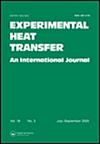锐边喷孔合成射流流动和热特性的实验研究
IF 2.9
3区 工程技术
Q2 ENGINEERING, MECHANICAL
引用次数: 4
摘要
本文章由计算机程序翻译,如有差异,请以英文原文为准。
Experimental investigation of flow and thermal characteristics of synthetic jet issuing from sharp-edged orifices
ABSTRACT The present experimental study reports the flow and heat transfer characteristics of a synthetic jet issuing from a sharp-edged orifice (diverging-shaped orifice). The experiments are carried out for a varied range of opening angles of sharp-edged orifices (θ = 0°, 30°, 60°, 90°, and 120°), Reynolds number (Re = 3243–8143), different jet-to-surface spacings (z/d = 1–16), and for two different values of orifice thicknesses, t = 5 mm (t/d = 0.33) and 10 mm (t/d = 0.66). The hot-wire anemometry is used to study the flow characteristics of synthetic jet, while heat transfer characteristics are studied by using a thermal imaging technique. The time-averaged flow fields associated with sharp-edged orifices reveal that orifices with t = 5 mm and 10 mm exhibit saddle-backed and top-hat velocity profile shapes, respectively. The results show that for a square-edge orifice (θ = 0°), the heat transfer rate decreases with an increase in orifice plate thickness from 5 to 10 mm, while the opposite trend in heat transfer is observed with sharp-edged orifice. The heat transfer rate with a 10 mm thick sharp-edged orifice is higher than the 5 mm thick sharp-edged orifice for all the tested opening angles. Furthermore, the results also show that for sharp-edged orifices, the heat transfer rate increases with the increase in opening angle from θ = 0° to 60°, while it decreases with further increasing from θ = 60° to 120°. The maximum value of average Nusselt number (Nuavg) is obtained for θ = 60° for both the orifice thicknesses (t = 5 and 10 mm), and this effect is found to be more pronounced for t = 10 mm orifice. For sharp-edged orifice (θ = 60°), the maximum enhancement in Nuavg is found to be 12.66% and 23% higher for t = 5 mm and 10 mm, respectively, compared to the equivalent square-edged orifice (θ = 0°). The cause for variation in heat transfer rate with sharp-edged orifices is interpreted due to the effect of flow recirculation and mass flow rate. A correlation has been proposed for Nuavg as a function of different opening angles. The present finding is useful for the optimization of the synthetic jet geometrical parameters for the effective heat transfer rate.
求助全文
通过发布文献求助,成功后即可免费获取论文全文。
去求助
来源期刊

Experimental Heat Transfer
工程技术-工程:机械
CiteScore
6.30
自引率
37.10%
发文量
61
审稿时长
>12 weeks
期刊介绍:
Experimental Heat Transfer provides a forum for experimentally based high quality research articles and communications in the general area of heat-mass transfer and the related energy fields.
In addition to the established multifaceted areas of heat transfer and the associated thermal energy conversion, transport, and storage, the journal also communicates contributions from new and emerging areas of research such as micro- and nanoscale science and technology, life sciences and biomedical engineering, manufacturing processes, materials science, and engineering. Heat transfer plays an important role in all of these areas, particularly in the form of innovative experiments and systems for direct measurements and analysis, as well as to verify or complement theoretical models.
All submitted manuscripts are subject to initial appraisal by the Editor, and, if found suitable for further consideration, to peer review by independent, anonymous expert referees. All peer reviews are single blind and submission is online via ScholarOne Manuscripts. Original, normal size articles, as well as technical notes are considered. Review articles require previous communication and approval by the Editor before submission for further consideration.
 求助内容:
求助内容: 应助结果提醒方式:
应助结果提醒方式:


